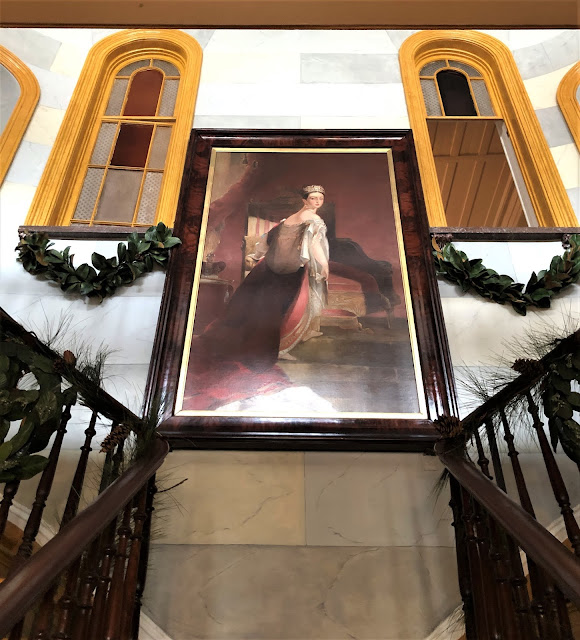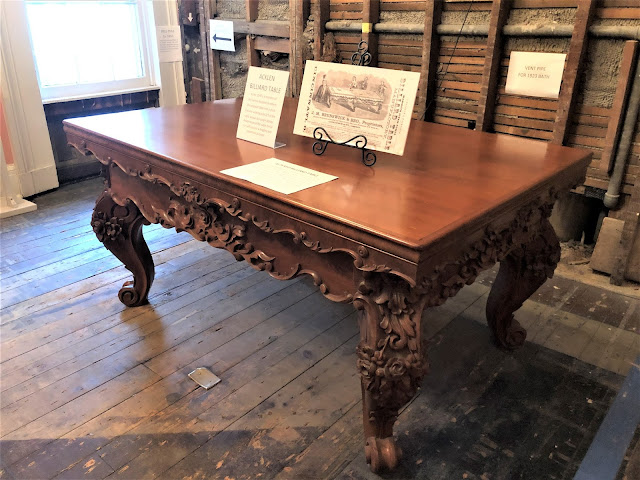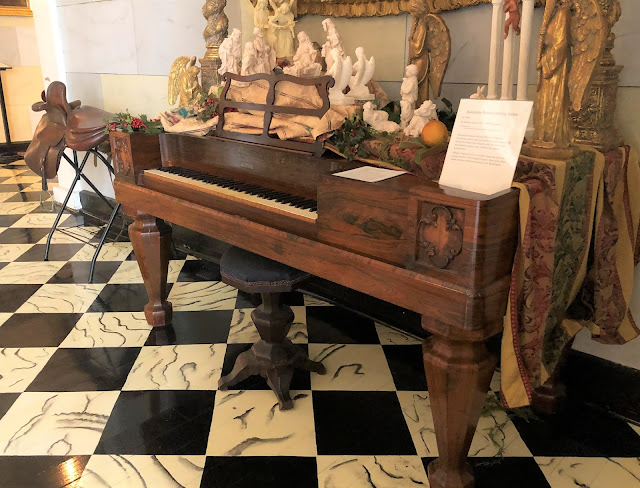In December 1864, as Union forces prepared for the Battle of Nashville, General Thomas J. Wood established his headquarters at the opulent Belmont Mansion, the home of one of the wealthiest women in the antebellum South: Adelicia Acklen.
 |
Union General Thomas J. Wood
used Belmont Mansion as
a headquarters in December 1864.
(Library of Congress) |
Acklen’s summer estate was a spectacle of privilege. The 177-acre property featured lavish gardens with statuary, a lake and deer parks, water fountains, a greenhouse, an art gallery, a bowling alley and even a zoo. The grandeur soon attracted Wood’s family as well; the 41-year-old general’s wife and cigar-smoking father-in-law joined him at Belmont, then considered one of the finest homes in the United States.
At the center of the estate stood a 36-room Italianate villa, crowned by an octagonal cupola that offered sweeping views of the countryside two miles south of Nashville. The 20,000-square-foot mansion embodied the wealth and confidence of the planter elite on the eve of the Civil War’s final year.
Acklen, whose first husband was among the nation’s most successful slave traders, derived her fortune from vast plantations in Tennessee, Mississippi and Louisiana, where hundreds of enslaved people labored under her control. In December 1864, that world of extraordinary luxury became a temporary command post for a Union army marching toward one of the war’s decisive battles.
Acklen's estate dazzled U.S. soldiers.
“One of the pretty Garden of Eden spots of the world,” 74th Ohio Sergeant George Theodore Copeland called it in a letter to his sister in June 1862 — three months after the U.S. Army occupied Nashville. “For acres the place is covered with hot houses. There is a tower on the place 110 feet high and by the time you get to the top of the winding stairs you are as tired as a ½ mile walk would make you.”
The mansion's impressive gardens astonished an Illinois soldier: “They are as handsomely layed out as the landscape gardener’s art can compass,” he recalled, “with statuary scattered all through the grounds and conservatories, arbors, cedars, spruce ‘galore’ and also an observatory.”
"Never before was [an] army headquarters so ornamented with such paintings and marbles,"
wrote a soldier in the 124th Ohio. "We, on the outside, were equally well off, for the spacious grounds were surrounded by nicely built stonewalls that were worked into chimneys ..."
Another Ohio soldier recalled: "Our line of works here at Nashville were run right through a princely mansion on our company front. The fine lace curtains on gilded windows, with costly upholstery, rich furniture and Brussels carpets, all spoke of great wealth."
 |
A circa-1864 image of the mansion
and fabulous grounds taken from
the 110-foot-high water tower. |
Indeed, the place was fit for a king — or, at the very least, a man with a deep appreciation for the finer things in life. Caroline Wood's father arrived at Belmont "laden with numerous boxes of cigars and other luxuries.”
A “kind and hospitable hostess,” Acklen “willingly consented to set aside one-half of the house for our accommodations,” Charles D. Hammer, a member of Wood’s staff, recalled decades after the war. “It was very large, beautifully furnished, and one-half would afford us ample room.”
Whether Acklen truly “willingly consented” is debatable; with Union forces in control of Nashville, her options were likely limited.
Thankfully, the mansion — the home/headquarters for two weeks for Wood, Hammer and another member of the general's staff — did not suffer irreparable battle damage,
as many houses in Fredericksburg, Va., had two years earlier during the battle there. The occasional Confederate musket fire struck the mansion in the lead-up to the Battle of Nashville and during the battle itself on Dec. 15-16. (A 2.5-inch Confederate grapeshot was discovered in the front yard during construction of a sidewalk in 2013.) Acklen was "quite successful," the
Chattanooga (Tenn.) Daily Times wrote in 1889, "in having Belmont protected from the ravages of marauders and vandals of both armies."
But the encamped U.S. Army ravaged the rest of Acklen's property and her adjoining farm, “Montvale." The art gallery east of the mansion suffered extensive damage.
 |
This water tower impressed
Union soldiers. |
Among the losses Acklen noted in a post-war damage claim filed to the U.S. government were one brick dwelling house with a tin roof, 3,000 yards of stone fence, 2,000 yards of picket fence, five beef cattle, six goats, 32 sheep, two mules, seven "milch" cows and 150 poultry. The Union Army used the stone for the construction of breastworks and cabins; soldiers used the fencing for firewood, among other uses. The poultry, cattle, goats, sheep and other animals? Well, you know what soldiers used them for.
Acklen — who married her third husband, a Nashville physician, after the war and
died at 70 in 1887 — was eventually reimbursed nearly $22,000 by the U.S. government. The socialite wasn't exactly hurting for cash: In 1859, she spent $3,000 for a 4,015-pound bell for a Nashville church. "Her manner of living," the
Daily Times wrote, "was regally sumptuous."
As Acklen edged into her 50s, she was determined to maintain her beauty. While in Paris after the war, "she resolved to have her face enameled by cosmetique process," according to a longtime Nashvillian, "and although warned it was a dangerous procedure, and might shorten her life, she persisted, with the declaration that she wished to be beautiful as long as she lived, no matter what the cost or risk to life she incurred."
In 2020 (hat tip, Andy Blair), I got an insider’s tour of Belmont Mansion, which decades after the war became a girls' academy and then the first building on the Belmont College campus. (Today the mansion is owned by the
Belmont Mansion Association and Belmont University. It's open to the public
for guided tours.)
 |
A view looking south from the cupola
-- that's the water tower in the distance.
(CLICK TO ENLARGE.) |
Sadly, the greenhouse, guest house, art gallery, zoo, lake and other extravagant trappings are long gone. Alas, so is the bowling alley. But I examined rooms used by Wood and his staff, admired some of Acklen's impressive, original furnishings and imagined how Army of the Cumberland commander George "Pap" Thomas felt when he strolled through the place in 1864. (Probably damn good —- this mansion is
impressive.)
The tour highlight was a visit to the 10-foot-high, original cupola, used by the Acklen family to view the heavens through a telescope and by Union Army observers to watch the battle to the south. Somehow I survived the journey back down to the second floor, grasping the shaky railings and gingerly navigating the narrow, wooden steps.
The stairs that once lifted Acklen’s family and soldiers toward the heavens still creak underfoot. Today, every step bears the weight of what this manion has witnessed: luxury, war, loss and survival.
 |
| This water fountain on the estate is in the same location it stood during the Civil War. |
 |
"By the time you get to the top of the winding stairs you are as tired as a ½ mile walk
would make you," a Union soldier wrote about the water tower on Acklen's estate.
Today, it's part of the Belmont University campus. |
- Adelicia Acklen war-time damage claim, National Archives, Washington, D.C. via fold3.com
- Chattanooga (Tenn.) Daily Times, Feb. 18, 1889
- Hammer, Charles D., "Reminiscences," April 1914, typewritten copy in Belmont Mansion Association archives
- Lewis, G.W. The Campaigns of the 124th Regiment, Ohio Volunteer Infantry, with Roster and Roll of Honor, Akron, Ohio, Werner Co., 1894)
- The Civil War Letters of George Theodore Copeland, Letter cited from June 2, 1862
- Mosman, Chesley, The Rough Side of War: The Civil War Journal of Chesley A. Mosman, 1st Lieutenant, Company D, 59th Illinois Volunteer Infantry Regiment, edited with biographical sketch by Arnold Gates, Basin Publishing Co., 1987
- Nashville Tennessean, Feb. 16, 1890
















Very interesting! Thank you for sharing! George Slaton
ReplyDeleteThank you for sharing this post. We now have another site to visit in the greater Nashville area!
ReplyDelete